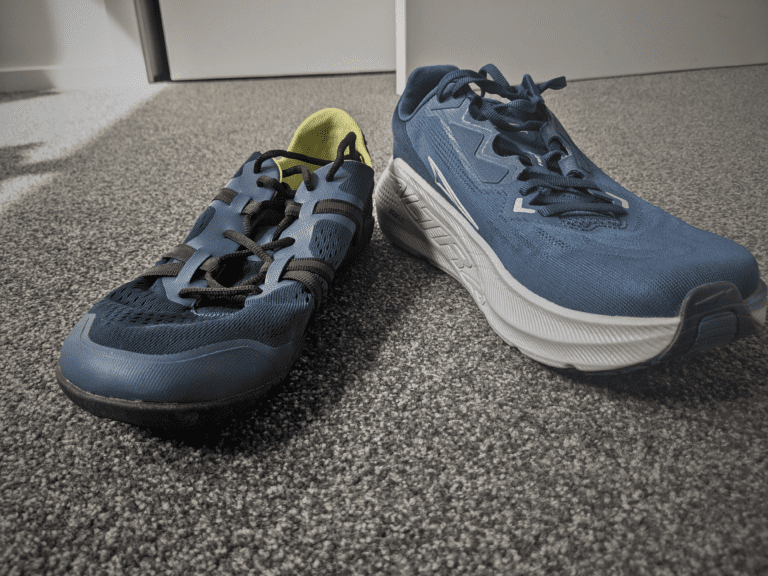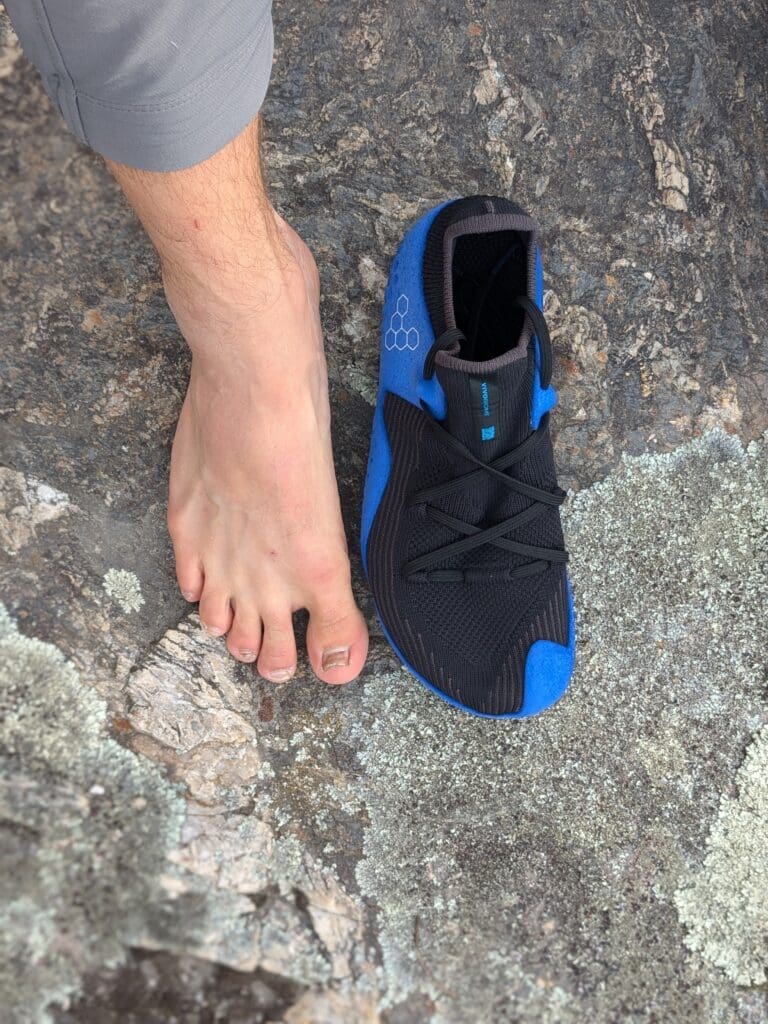If you’re reading this post, I hope you’ve read Step 1 in Barefoot Running first, as it’s essential to understanding how to stave off injuries when first dipping your toe into barefoot running.
But since you’re here, I’m going to assume you’re a convert to everyday minimal footwear, and you’re ready to start running in minimal shoes too!
So how do you start?
Head out for a slow 5km!?
Nope, sorry.
In this post, I’ll share the ideal formula necessary to build up your minimal running so you can reach your barefoot goals –without injuring yourself!
Because guess what?! It’s not about running barefoot 100% of the time. You can actually reap the benefits of minimalism by completing only some of your training sessions in minimal shoes.
It’s your preference.
It’s been 12 weeks since you started walking around in minimal footwear, and you’re ready to run.
Running barefoot/minimal puts tremendous stress on your body compared to walking. We’re talking forces of 2-3x your body weight for every step you run. Walking comes in at just over 1x your body weight.
So as you can imagine, your body will be working hard.
To mitigate any gait issues, I will first invite you to run completely barefoot.
That’s right. No shoes at all! By why?
Any material between you and the ground will affect the feedback your feet receive from the ground, manipulating your running gait.
First, I’d like you to feel true barefoot running. Go outside on a small section of pavement where you can be sure there are no sharp objects, run for ~10 seconds, and run back.
If you must wear socks, that’s fine, but allowing the feet to behave naturally is essential.
Again, don’t practice this on soft ground or grass because that’ll affect your running gait.
I want you to pay attention to
- How your foot lands naturally.
- The length of your stride
- Your upper body position
How does it feel?
It’ll likely be a drastic difference compared to running in conventional shoes.
I want you to take this feeling forward.
Every time you slip on minimal running shoes, recall the speed of your steps, how your foot lands, and your posture during your stride, and let your body flow through this motion.
If you’re deviating from this barefoot running feel, take your shoes off again. Do a few more 10-second runs. And regain that feeling again.
Don’t expect to go far.
In fact, I suggest your first run in minimal shoes should be the first 5 minutes of one of your training sessions. Not an entire training session.
If you run from your house, just run in your minimal shoes around the block and then transfer back into your other running footwear before your ‘bigger’ run.
I don’t want you to blast out your fastest kilometer. Instead, I want you to feel comfortable at a pace where you can still hold a conversation without losing your breath. And focus on the feeling.
Do this twice per week, spaced out roughly throughout the week. Totaling 10mins of minimal running for the week!
I know, that sounds silly, doesn’t it? Just 10 minutes. But don’t underestimate the stress it puts on your body.
It’s not just the strain you feel in your muscles.
The bigger risk is damage to your joints and bones. It’s much harder to sense the signs of a fracture before it becomes a big problem, so the only way to mitigate this is to be very conservative.
If you feel any discomfort, STOP and walk home. And on another day, practice barefoot running again, and try to identify any differences you felt when running in minimal shoes.
So again. To start with, you want to run 5 minutes in minimal shoes, 2 times per week.
Which minimal running shoe is for you?
Take a quick 5-question quiz to identify the perfect minimal running shoe for your feet! You'll get both road and trail options based on your answers!
Now that we’re starting to run in minimal shoes, it’s important to know at what pace to progress.
I will outline a slow progression to get you to 1 hour of weekly barefoot running.
Trust me, that’s a lot. And maybe the max you want to do? But we’ll get to that later.
The following progression assumes you have no physical issues in your regular training.
All minimal sessions should be performed at a pace where you can still hold a conversation without losing your breath.
| Week 1 | 2 x 5mins |
| Week 2 | 2 x 6mins |
| Week 3 | 2 x 7mins |
| Week 4 | 2 x 8mins |
| Week 5 | 2 x 9mins |
| Week 6 | 2 x 10mins |
| Week 7 | 2 x 12mins |
| Week 8 | 2 x 14mins |
| Week 9 | 3 x 10mins |
| Week 10 | 3 x 12mins |
| Week 11 | 3 x 14mins |
| Week 12 | 3 x 16mins |
| Week 13 | 3 x 18mins |
| Week 14 | 3 x 20mins |
Feel free to incorporate these workouts into your current training sessions, although I’d suggest fitting them in at the start of a session to perfect your form when you are not fatigued.
Until week 8, you will run in minimal shoes twice weekly, maxing out at 14 mins per session. And beyond this point, you’ll transfer to 3 sessions per week.
At the end of week 14, you will have completed a full hour of minimal running for the week! That’s huge.
At that point, you’ll have an excellent foundation to vary your minimal training sessions to focus on different areas of your running.
At week 15, you’ll likely feel like you can run for hours in your minimal shoes!
And I’d love you to have that freedom, BUT it’s still not wise to do so, considering your longest barefoot run would be 20mins.
You’re at a point where you’ll be seeing the benefits of barefoot running, and maybe you’re happy to stick to a few maintenance sessions per week.
Others may want to push beyond this and look into different training sessions to strengthen their barefoot gait.
- Interval training in minimal shoes.
- Hill repeats in minimal shoes.
- Threshold runs in minimal shoes.
These will all be much harder than anything you’ve attempted previously, and I’d advise you to stick to relatively short durations with these workouts or switch your shoes out when logical.
If you want extra guidance, my inbox is always open on Instagram and via email. We can talk about your specific running goals and design workouts that would benefit you the most!
No matter what stage you’re at in week 15, you’ll be in a better place than where you started, and running will never be the same again!



